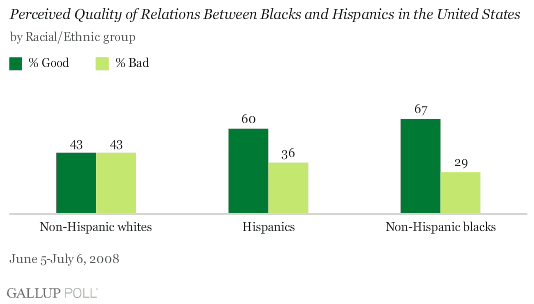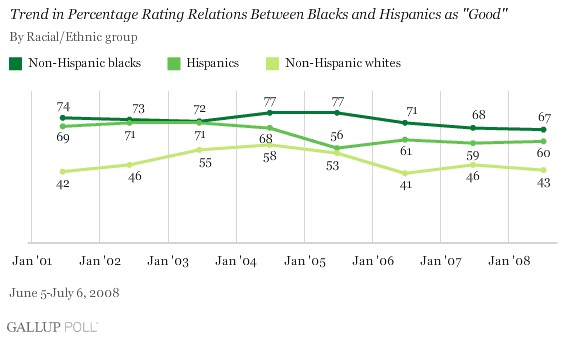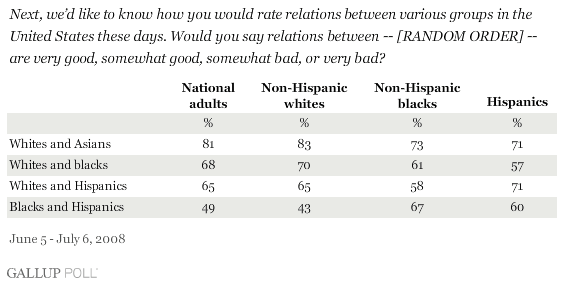PRINCETON, NJ -- Fewer than half of white adults in the United States -- contrasted with 60% of Hispanics and two-thirds of blacks -- believe good relations exist between U.S. blacks and Hispanics.

Blacks are clearly the most upbeat of the three groups about the state of black-Hispanic relations, as only 29% of blacks, compared with 36% of Hispanics and 43% of whites, say relations are bad. But Hispanics are significantly more positive than whites.
These findings are from the 2008 installment of Gallup's Minority Rights and Relations survey, conducted each June since 2001. This year's survey, fielded June 5 to July 6, includes interviews with 608 blacks and 502 Hispanics, and includes Spanish-language interviewing with nearly a quarter of the Hispanic sample. The black and Hispanic samples are weighted so they are correctly represented in the national totals.
The 2008 Gallup results are not new. For each of the past eight years, whites have had a substantially worse opinion than have blacks of black-Hispanic relations. And for most of this period, whites have had a more negative view than Hispanics.

Gallup's race-relations question asks all Americans to rate relations between blacks and Hispanics as either "very good," "somewhat good," "somewhat bad," or "very bad." Because of the relatively less positive perspective of whites, just 49% of Americans as a whole believe these relations are good, while 40% perceive them to be bad. This makes black-Hispanic relations the worst rated of the four racial/ethnic pairings measured in the survey.
Eighty-one percent of Americans see whites and Asians as getting along well, while about two-thirds of Americans consider both white-black and white-Hispanic relations positive.

The issue has obvious importance this election year, with Barack Obama soon to become the nation's first black on the ballot as a major-party candidate for president. Obama had difficulty carrying the Hispanic vote in the Democratic primaries earlier this year -- something that led to considerable media speculation about black-Hispanic animosity as the cause -- but Gallup polling has shown him solidly beating Republican John McCain among Hispanics throughout the campaign.
Just focusing on Hispanic Democrats (who favored Hillary Clinton over Obama, 52% to 44% for the nomination in Gallup Poll Daily tracking throughout May), 84% in May said they would vote for Clinton in a Clinton vs. McCain matchup in November, compared with 80% who said they would vote for Obama if the choice were Obama vs. McCain.
Hispanics preferred Clinton over Obama for the Democratic nomination, but they were not so opposed to Obama (or the idea of electing a black president) that they were willing to vote for McCain in the general election.
Bottom Line
The generally positive review of black-Hispanic relations in Gallup polling among members of the two leading U.S. minority groups contrasts with considerable media speculation about the impact of Hispanic animosity toward blacks in this year's primary elections.
Some of that commentary has speculated that the trend is getting worse as the Hispanic population grows and starts to outnumber blacks in some neighborhoods and entire cities. Others posit that older Hispanics are more likely than the younger generation to harbor biases and resentments against blacks.
In a January 2008 New York Times article titled, "In Obama's Pursuit of Latinos, Race Plays Role," the authors write, "Mr. Obama confronts a history of often uneasy and competitive relations between blacks and Hispanics, particularly as they have jockeyed for influence in cities like Chicago, Los Angeles, and New York. 'Many Latinos are not ready for a person of color,' Natasha Carrillo, 20, of East Los Angeles, said. 'I don't think many Latinos will vote for Obama. There's always been tension in the black and Latino communities. There's still that strong ethnic division. I helped organize citizenship drives, and those who I've talked to support Clinton.'"
While black-Hispanic animosity may exist and could even have been a factor in some state caucuses or primaries, the Gallup data indicates it is not overwhelmingly obvious to members of either group. Whites are much more likely to believe the two are in conflict.
Survey Methods
Results are based on telephone interviews with 1,935 national adults, aged 18 and older, conducted June 5-July 6, 2008, including oversamples of blacks and Hispanics that are weighted to reflect their proportions in the general population. For results based on the total sample of national adults, one can say with 95% confidence that the maximum margin of sampling error is ±4 percentage points.
For results based on sample of 702 non-Hispanic whites, the maximum margin of sampling error is ±5 percentage points.
For results based on sample of 608 non-Hispanic blacks, the maximum margin of sampling error is ±5 percentage points.
For results based on sample of 502 Hispanics, the maximum margin of sampling error is ±6 percentage points (120 out of the 502 interviews with Hispanics were conducted in Spanish).
Interviews are conducted with respondents on land-line telephones (for respondents with a land-line telephone) and cellular phones (for respondents who are cell-phone only).
In addition to sampling error, question wording and practical difficulties in conducting surveys can introduce error or bias into the findings of public opinion polls.
To provide feedback or suggestions about how to improve Gallup.com, please e-mail feedback@gallup.com.
